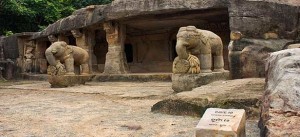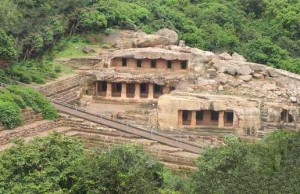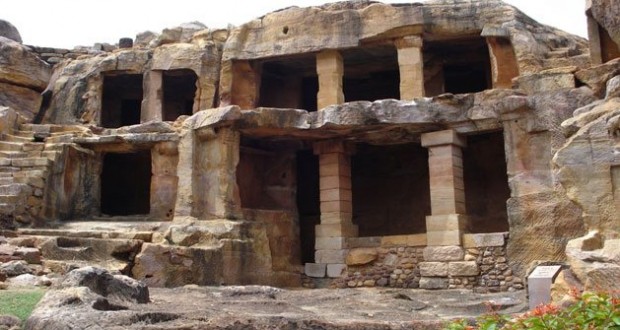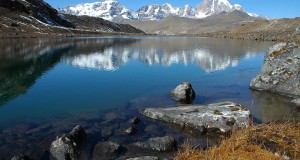The OTDC conducted tour covers the above spots plus the old town temples in any order, depending on the mood of the driver. If you’ve already seen the temples, suggest that they’re made the last stop of the day so you can leave the tour early. Some 8 km (5 miles) out of town you’ll visit the Khandagiri and Udayagiri Hills, honeycombed with ancient caves. These were excavated by monks during the reign of Kharavela, the Kalinga emperor, around the 1st and 2nd centuries BC. Udayagiri has 44 caves, all carved out of sandstone. Their entrances are decorated with monkey (Hanuman) or elephant (Buddha) motifs, and are often adorned with Pali inscriptions. Several caves functioned as monks’ sleeping quarters, and contain bare rockbeds.
 The central Hathi Gumpha (Elephant Cave) exhibits the best example of Pali records so far found in India: a full listing of Kharavela’s religious, military and civil achievements during the first 13 years of his reign. An ingenious underground water supply runs right through the caves, originating from a central reservoir. Above and to the left of Udayagiri, are the group of 19 Khandagiri caves. On top of Khandagiri hill, you’ll find 24 Jain statues of great beauty in the 18th-century temple of Mahavir (founder of the Jain religion). There are nice views from the summit too.The Nandankanan Biological Park, 20 km (121/2 miles) out of Bhubaneshwar, is an attractive botanical garden and zoo set amid the forest and lakes of Chandaka. The largest lion safari park in India, it is also the first zoo in the world where white tigers have been bred naturally in captivity. The animals here live in semi-tropical splendour, often in quarters superior to those of their human visitors. They include rhinos, monkeys, gharials, pelicans, pythons, brown bear, and crocodile. In March, there’s a colourful host of wild butterflies. For a quick orientation round the zoo grounds, take a ride on the toy train which
The central Hathi Gumpha (Elephant Cave) exhibits the best example of Pali records so far found in India: a full listing of Kharavela’s religious, military and civil achievements during the first 13 years of his reign. An ingenious underground water supply runs right through the caves, originating from a central reservoir. Above and to the left of Udayagiri, are the group of 19 Khandagiri caves. On top of Khandagiri hill, you’ll find 24 Jain statues of great beauty in the 18th-century temple of Mahavir (founder of the Jain religion). There are nice views from the summit too.The Nandankanan Biological Park, 20 km (121/2 miles) out of Bhubaneshwar, is an attractive botanical garden and zoo set amid the forest and lakes of Chandaka. The largest lion safari park in India, it is also the first zoo in the world where white tigers have been bred naturally in captivity. The animals here live in semi-tropical splendour, often in quarters superior to those of their human visitors. They include rhinos, monkeys, gharials, pelicans, pythons, brown bear, and crocodile. In March, there’s a colourful host of wild butterflies. For a quick orientation round the zoo grounds, take a ride on the toy train which  circles the perimeter. Alight at the new Lion Safari Park at the top of the complex. Buses run visitors out every half hour or so (Rs3) to see African lions (often asleep) in the vast 20-hectare (50-acre) reserve. Otherwise, you can hire a pedal- or rowing-boat on the lake, or pay a brief visit to the Botanical Gardens north of the zoo, with its wide variety of indigenous and exotic plants. Nandankanan is open 7 am-6 pm (April-September), 7.30 am-5 pm (September-March) daily except Monday. Admission is Rs2. If not on tour, visit by local bus—there’s an hourly service from Bhuhaneshwar .The bright-white Japanese peace pagoda on top of Dhauli hill 8 km (5 miles) from town can be seen for many miles. Bedecked with gilded lions, this Santi Stupa has five types of ‘umbrella’—representing the five ancient Buddhist virtues of faith, hope, compassion, forgiveness and non-violence. It overlooks the vast plain where Ashoka destroyed the might of the Kalinga empire, and then dedicated himself to peace. At the foot of Dhauli hill, you may see the famous Ashoka Rock Edicts—inscribed by the repentant emperor after being converted to Buddhism by a resident monk. Above the edicts there is the earliest known sculpture in Orissa, the forepart of an elephant (representing Buddha) hewn out of a huge rock. Dhauli is a quiet, scenic spot with beautiful views in all directions. At the top of the hill, behind the white-domed pagoda, is a small Hindu temple of Lord Dhaveleswar which was reconstructed in 1992.Orissa State Museum, just below the railway track in the old part of town, is a large sprawling building with a rich collection of tribal art and many interesting archaeological finds. The excellent Heritage of Orissa exhibition has a
circles the perimeter. Alight at the new Lion Safari Park at the top of the complex. Buses run visitors out every half hour or so (Rs3) to see African lions (often asleep) in the vast 20-hectare (50-acre) reserve. Otherwise, you can hire a pedal- or rowing-boat on the lake, or pay a brief visit to the Botanical Gardens north of the zoo, with its wide variety of indigenous and exotic plants. Nandankanan is open 7 am-6 pm (April-September), 7.30 am-5 pm (September-March) daily except Monday. Admission is Rs2. If not on tour, visit by local bus—there’s an hourly service from Bhuhaneshwar .The bright-white Japanese peace pagoda on top of Dhauli hill 8 km (5 miles) from town can be seen for many miles. Bedecked with gilded lions, this Santi Stupa has five types of ‘umbrella’—representing the five ancient Buddhist virtues of faith, hope, compassion, forgiveness and non-violence. It overlooks the vast plain where Ashoka destroyed the might of the Kalinga empire, and then dedicated himself to peace. At the foot of Dhauli hill, you may see the famous Ashoka Rock Edicts—inscribed by the repentant emperor after being converted to Buddhism by a resident monk. Above the edicts there is the earliest known sculpture in Orissa, the forepart of an elephant (representing Buddha) hewn out of a huge rock. Dhauli is a quiet, scenic spot with beautiful views in all directions. At the top of the hill, behind the white-domed pagoda, is a small Hindu temple of Lord Dhaveleswar which was reconstructed in 1992.Orissa State Museum, just below the railway track in the old part of town, is a large sprawling building with a rich collection of tribal art and many interesting archaeological finds. The excellent Heritage of Orissa exhibition has a  wide-ranging display of bronze images, tribal arts, stone inscriptions and anthropological specimens, also sculptures, coins, handicrafts, minerals and items of natural history. The old temple dharani inscriptions, mainly on stone tablets or blocks of wood, are of particular interest. The cultural Rainbow’s Edge exhibition has a fine display of folk and traditional paintings, mostly inspired by legends, myths and folklore. Also many intricate tribal wall and floor paintings, similar to those that can be found in Oriyan homes even today. Despite poor lighting, and a rather gloomy, mothballed natural history section, this very representative collection is well displayed and worth a visit. Open 10 am-5 pm daily (except Monday). Free guide service.
wide-ranging display of bronze images, tribal arts, stone inscriptions and anthropological specimens, also sculptures, coins, handicrafts, minerals and items of natural history. The old temple dharani inscriptions, mainly on stone tablets or blocks of wood, are of particular interest. The cultural Rainbow’s Edge exhibition has a fine display of folk and traditional paintings, mostly inspired by legends, myths and folklore. Also many intricate tribal wall and floor paintings, similar to those that can be found in Oriyan homes even today. Despite poor lighting, and a rather gloomy, mothballed natural history section, this very representative collection is well displayed and worth a visit. Open 10 am-5 pm daily (except Monday). Free guide service.
Around sunset, try a relaxing rickshaw ride around Bhubaneshwar town. It’s an interesting little place, which comes alive in the evening when the heat is down. Start with a pleasant ride north out of town. On your return, look out for the lines of patient egg-sellers seated by the roadside with their tidy little mountains of eggs lit by a single, flickering oil-lamp. Coconut, banana and nut vendors also have their small illuminated ‘patches’ here. Riding down the otherwise pitch-black highway, all these little lamps give the general effect of a deserted, flare-lit airport runway.





